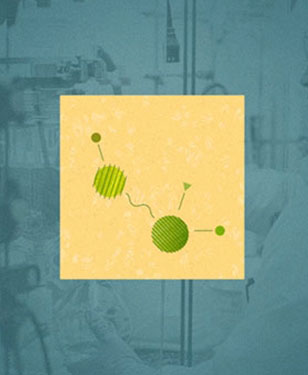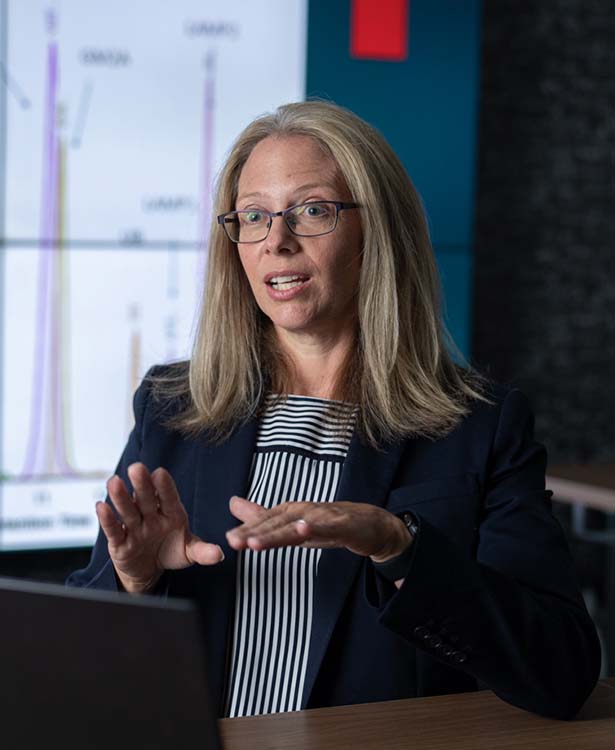Junghae Suh, Ph.D., head of Biogen’s Gene Therapy Accelerator Unit (GTxAU), often walked through this nondescript hallway, like so many other hallways on the Johns Hopkins University medical campus, but on this day a research poster on the wall caught her eye. The poster described a biophysical technique that can be used to measure the forces at play in cells. She knew instantly that this technique could be applied to studying the obstacles of gene therapy.
Stories
Junghae Suh –
Where curiosity meets purpose

November 04, 2021
Junghae Suh, Ph.D.
Head of Biogen Gene Therapy Accelerator Unit (GTxAU)
Decades of biological research have unveiled the genetic causes of many debilitating diseases. This knowledge unlocks the promise and potential of gene therapy: a drug administered one time that can modify the genetic information in a patient’s cells. This mechanism makes it possible to provide treatments that were once only imagined. Depending on the disease, scientists can use different strategies to target the genetic trigger. For example, scientists can genetically modify a patient’s chromosome to either introduce a healthy copy of a gene into a patient’s cells or shut off the mutant gene. Gene therapies have the potential to one day dramatically change how humans respond to disease, moving from disease management to transformative medicines that may potentially prevent, halt, or cure a disease with one injection.
For Junghae, pausing to read that poster on the wall years ago marked the beginning of her journey in the field of gene therapy, leading her to discover a new approach to track and measure the way gene therapies move within live cells.1
For years, researchers worked to understand what stopped gene therapies from reaching the nucleus of a cell and delivering their therapeutic package. Using Junghae’s approach, researchers could see a real-time movie of the gene therapy in cells, instead of just snapshots. By seeing particles travel through cells, Junghae determined that the gene therapy was stuck on the intracellular highway with no exit ramp to the nucleus.
By understanding the problem, Junghae could focus on a solution. She looked to nature for inspiration, pursuing a postdoctoral research fellowship in a fundamental virology laboratory at the Salk Institute for Biological Studies.
Engineering viruses
Gene therapies may use viruses to deliver therapeutic genes into patients
For gene therapy, a virus’s ability to enter a host cell and deliver genetic instructions, ultimately changing how the cell operates, means that viruses could be used as delivery vehicles (vectors). By modifying naturally occurring viruses into these useful vectors, scientists can leverage the original virus’s ability to enter cells and deliver their genetic payload that has been replaced with one that would treat the disease.
For Junghae, this idea held tremendous promise for the future. Armed with this newfound knowledge, following her postdoc, she started her independent academic lab at Rice University in the Department of Bioengineering in 2007.
Trained as an engineer, Junghae looks at virology from a very different perspective. Her creative work pushed other researchers in the field to look at viral capsid engineering in new ways.
Junghae unpacking lab equipment at her academic research lab at Rice University in 2009
“I didn’t know where my independent research was headed, but I hung on to the idea of applying engineering thinking to the design of viruses for gene therapy. What did that mean? I had no clue back when I first started the lab. All I wanted was to see one of the ‘crazy’ ideas we had on paper actually work,” says Junghae.
After more than 12 years in academia, where she was driven by intellectual curiosity and a desire to push the envelope of biomolecular design, Junghae was ready for a new challenge where the impact of her work could be much broader: translating scientific discoveries into therapies with the potential to change the lives of those living with debilitating neurological diseases. This brought her to Biogen.
Engineering viruses
In August 2019 Junghae joined Biogen to lead the company’s Gene Therapy Accelerator Unit (GTxAU).
The GTxAU was created by Anabella Villalobos, Ph.D., head of Biogen’s Biotherapeutics & Medicinal Sciences organization, with the goal of making Biogen a leader in the application of gene therapy in neuroscience. With the potential for curative therapies, the GTxAU’s mission is to improve the quality of life for patients, families and caregivers.
Anabella Villalobos, Ph.D.
Senior Vice President, head of Biogen’s Biotherapeutics & Medicinal Sciences group
“I started my scientific career not knowing what I wanted to focus on other than wanting to learn and to contribute original ideas that have the potential to impact real-world problems,” says Junghae. “During my academic career, I was driven by the satisfaction of connecting the dots between adjacent technologies and scientific approaches to solve interesting problems in biomedicine.
“When I think of gene therapy, I think of cures,” says Anabella. “Though treating neurological disorders is one of the most difficult areas of medicine, the potential for a therapy that could stop a disease with one shot is more than worth the time and effort.”
This potential for cures is what drives Junghae and her team.
“Today, my purpose is the clearest it has ever been: to deliver potentially life-transforming gene therapy medicines to patients. It is a monumental challenge, but the time has come to make the promise of gene therapy a reality.”
There are still many questions that need to be answered; answers that Junghae and her team are driven to find with the hope to alter the course of neurological disorders. As they continue to work toward that goal, Biogen is preparing for that future by building a manufacturing facility dedicated to delivering reliable gene therapies to patients around the world.
Throughout her career, Junghae has received numerous awards, including the American Society of Gene and Cell Therapy Outstanding New Investigator Award (2016). Most recently, she was inducted into the American Institute for Medical and Biological Engineering (2021).





